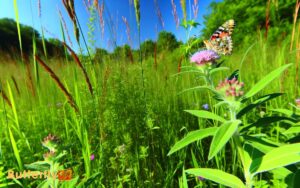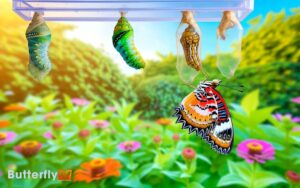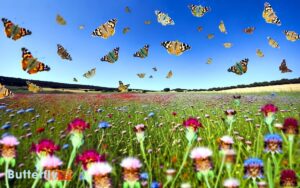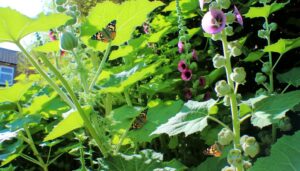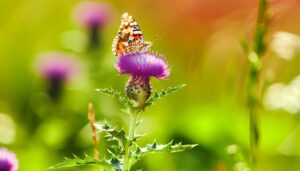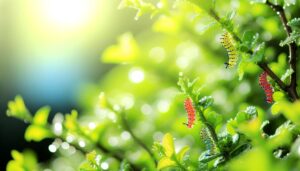American Painted Lady Butterfly Facts: Key Insights!
The American Painted Lady butterfly (Vanessa virginiensis), part of the Nymphalidae family, exhibits remarkable eye spots on its hindwings that deter predators by mimicking larger eyes. Its distinctive scalloped wing edges aid in camouflage and efficient flight.
This species thrives in diverse habitats from Canada to Mexico, favoring open areas rich in nectar. Its lifecycle includes egg, larva, pupa, and adult stages, with the larvae feeding primarily on thistle and hollyhock leaves.
With significant roles in pollination and ecosystem health, the American Painted Lady is an indicator species for environmental changes. Discover more fascinating aspects of this butterfly’s life and contributions.
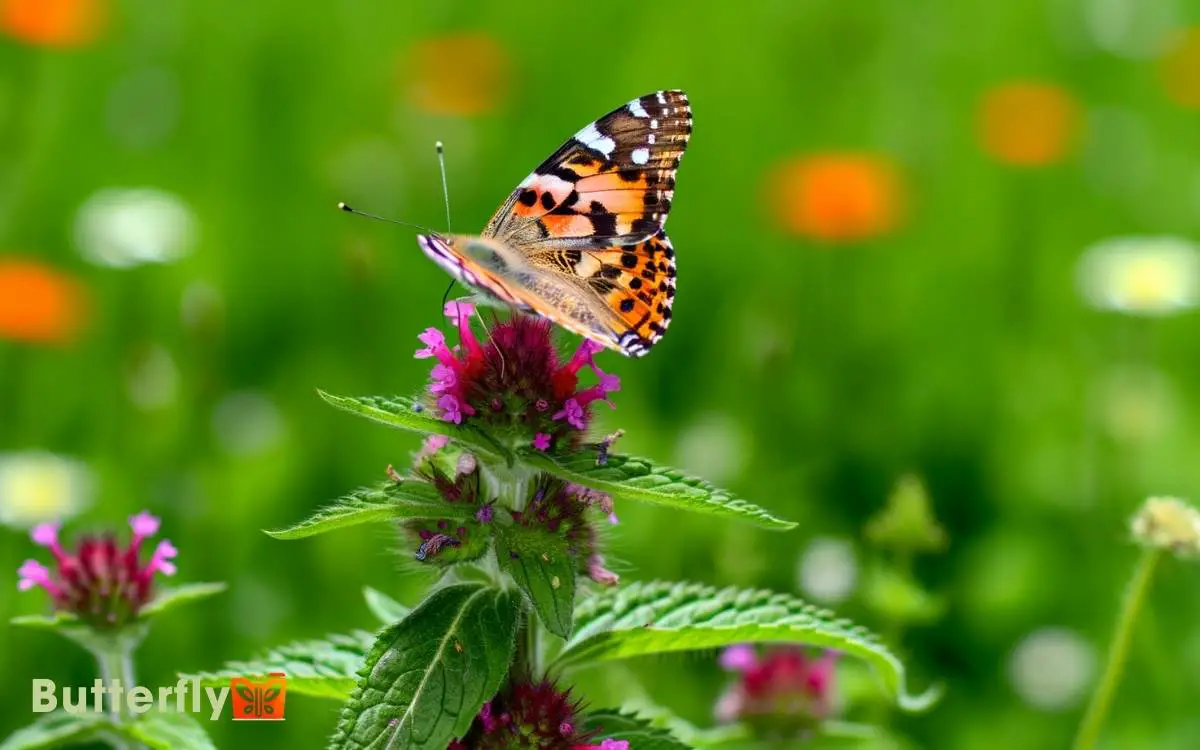
Key Takeaways
Scientific Classification
The American Painted Lady butterfly, scientifically known as Vanessa virginiensis, belongs to the family Nymphalidae, which is celebrated for its diverse and colorful species.
Within this family, Vanessa virginiensis is classified under the genus Vanessa, a group known for its migratory patterns and adaptability to various habitats.
The taxonomic hierarchy places it in the order Lepidoptera, encompassing all butterflies and moths, characterized by their scaled wings and complete metamorphosis.
Vanessa virginiensis shares its subfamily, Nymphalinae, with other remarkable genera. This classification underscores its evolutionary relationships and ecological roles.
Understanding its scientific classification helps in comprehending its behaviors, migration routes, and interactions within ecosystems, providing essential insights for conservation and study.
Distinctive Wing Patterns
The American Painted Lady butterfly exhibits distinctive wing patterns characterized by colorful eye spots and unique wing shapes. These patterns can vary seasonally, with changes in coloration and markings.
Such variations aid in camouflage and predator deterrence, highlighting the butterfly’s adaptive strategies.
Colorful Eye Spots
Colorful eye spots on the wings of the American Painted Lady butterfly serve as a defense mechanism against predators. These striking patterns confuse or intimidate potential threats, increasing the butterfly’s chances of survival.
The eye spots resemble the eyes of larger animals, which can deter predators like birds and lizards. The precise arrangement and vivid colors play an essential role in this mimicry.
Key characteristics of these eye spots include:
- Size: Typically large and prominent, making them highly visible.
- Location: Found primarily on the lower sides of the hindwings.
- Color: A combination of black, white, and sometimes iridescent blue.
- Function: Act as decoys, drawing attacks away from important body parts.
Understanding these features highlights the butterfly’s remarkable adaptation strategies.
Unique Wing Shapes
Boasting uniquely scalloped edges, the wings of the American Painted Lady butterfly exhibit intricate patterns that aid in camouflage and species identification.
These patterns consist of a complex array of colors and shapes, including the recognizable eye spots and bands of orange, black, and white. The wing shapes and patterns serve multiple functions, from deterring predators to attracting mates.
| Feature | Function | Emotional Impact |
|---|---|---|
| Scalloped Edges | Camouflage | Awe at nature’s artistry |
| Eye Spots | Predator Deterrence | Fascination with survival |
| Color Bands | Mate Attraction | Appreciation of beauty |
| Wing Shape | Flight Efficiency | Wonder in adaptability |
| Patterns | Species ID | Curiosity about diversity |
These distinctive markers enable the butterfly to thrive in various environments, illustrating nature’s ingenious designs.
Seasonal Pattern Variations
During different seasons, American Painted Lady butterflies exhibit variations in their wing patterns, adapting to environmental changes for optimal survival and reproduction. These seasonal pattern variations are driven by temperature, daylight, and availability of resources.
Here are some key points:
- Spring Patterns: In spring, their wings often display brighter and more vibrant colors to attract mates and optimize mating success.
- Summer Patterns: During summer, the butterflies may show more muted tones, aiding in thermoregulation and avoiding overheating.
- Autumn Patterns: Fall patterns tend to be darker and more subdued, providing better camouflage against predators as they prepare for migration.
- Winter Adaptations: In warmer regions, slight modifications in patterns help with thermoregulation and energy conservation during cooler temperatures.
These adaptive changes ensure their survival across varying seasonal conditions.
Habitat and Range
The American Painted Lady butterfly, scientifically known as Vanessa virginiensis, thrives in a wide range of habitats including meadows, fields, roadsides, and gardens across North America.
This butterfly is particularly adaptable, making it a common sight from Canada to Mexico. It prefers open areas with abundant nectar sources and host plants for its larvae. Its ability to occupy diverse environments contributes to its widespread distribution.
Here’s a quick overview of its preferred habitats and range:
| Habitat Type | Key Features | Geographic Range |
|---|---|---|
| Meadows | Open areas with wildflowers | North America |
| Fields | Grassy areas, often cultivated | Canada to Mexico |
| Roadsides | Margins with flowering plants | Throughout the continent |
| Gardens | Cultivated with nectar plants | Urban and suburban areas |
| Woodlands’ edges | Transitional zones | Across North America |
This ecological adaptability guarantees Vanessa virginiensis remains a vibrant part of various ecosystems.
Lifecycle Stages
Understanding the lifecycle stages of the American Painted Lady butterfly reveals the intricate processes of metamorphosis and survival strategies.
This butterfly undergoes complete metamorphosis, involving four distinct stages:
- Egg: Tiny and green, eggs are laid singly on host plants, often on the underside of leaves.
- Larva: Known as caterpillars, they hatch from eggs and feed voraciously, growing through several instars, or molts.
- Pupa: Caterpillars form a chrysalis, within which they undergo transformation. The pupa stage is critical for developing adult structures.
- Adult: Emerging from the chrysalis, the adult butterfly has vibrant wings and begins the cycle anew by mating and laying eggs.
Each stage is essential for the butterfly’s development and survival in its environment.
Feeding Habits
With keen precision, the American Painted Lady butterfly utilizes its proboscis to extract nectar from a variety of flowering plants.
They favor plants such as thistles, asters, and cosmos, which provide abundant nectar. The proboscis acts like a straw, allowing the butterfly to reach deep into the flower’s structure.
This feeding mechanism guarantees they optimize their energy intake while aiding in cross-pollination. Additionally, they may consume tree sap, rotting fruit, and even bird droppings to supplement their diet with essential nutrients and minerals.
The ability to derive nourishment from diverse sources contributes to the American Painted Lady’s adaptability and survival in different habitats. This varied diet supports their energy needs, particularly during their reproductive and migratory phases.
Migration Patterns
During the fall, American Painted Lady butterflies begin their long-distance migrations to warmer climates, ensuring their survival through the winter months.
These migrations are primarily driven by temperature changes and the availability of food sources. They travel southward to areas such as the southern United States and Mexico.
Their journey is guided by several environmental cues:
- Temperature: A drop in temperature triggers the start of their migration.
- Day Length: Shorter days signal the butterflies to move to warmer regions.
- Food Scarcity: Declining nectar sources prompt the need to relocate.
- Wind Patterns: Favorable winds assist in their southward flight.
Understanding these patterns highlights the butterfly’s remarkable adaptation to seasonal changes. Their migration is an essential behavior for their survival and reproduction.
Predators and Threats
American Painted Lady butterflies face numerous predators and threats that greatly impact their survival rates. Birds, spiders, and predatory insects actively prey on these butterflies, while parasitic wasps and flies target their larval stages.
Pesticides and habitat destruction also pose significant risks, reducing available resources and breeding sites.
| Predator Type | Specific Example | Impact on Butterfly |
|---|---|---|
| Birds | Sparrows | Prey on adults |
| Spiders | Orb-weaving spiders | Trap in webs |
| Predatory Insects | Praying mantises | Attack adults and larvae |
| Parasitic Wasps | Cotesia congregata | Parasitize larvae |
Chemical pollutants further exacerbate these threats by contaminating nectar sources, affecting both adults and larvae. Understanding these challenges is essential for conservation efforts aimed at preserving the American Painted Lady butterfly.
Role in Ecosystem
Despite facing numerous threats, the American Painted Lady butterfly plays an essential role in its ecosystem by acting as both pollinator and prey, thereby contributing to the biodiversity and health of various habitats.
These butterflies assist in pollination by transferring pollen as they feed on nectar from various flowers. This process promotes plant reproduction and genetic diversity.
Additionally, they serve as a food source for a range of predators, including birds and spiders.
Key roles include:
- Pollination: Enhances plant reproduction and genetic variability.
- Prey: Supports the food web by feeding birds, spiders, and other predators.
- Nectar source: Provides sustenance for other insects when feeding on flowers.
- Indicator species: Reflects the health of their environment, helping scientists monitor ecosystem integrity.
Conservation Status
The American Painted Lady butterfly’s population trends indicate relative stability, yet localized declines have been observed.
Primary threats include habitat loss, pesticide use, and climate change, which affect their survival and reproductive success.
Conservation efforts must tackle these threats to guarantee the species’ long-term viability.
Current Population Trends
Current data reveals fluctuations in the American Painted Lady butterfly population, influenced by environmental changes and habitat loss. These fluctuations are documented through various scientific methods that provide insight into their current status.
Recent studies indicate:
- Seasonal Migrations: Populations vary due to migratory patterns, with numbers peaking during warmer months.
- Climate Variability: Shifts in climate conditions affect breeding and survival rates.
- Habitat Fragmentation: Urban development and agriculture reduce available habitats, impacting population density.
- Monitoring Efforts: Citizen science projects and professional surveys contribute valuable data on population trends.
Understanding these trends is essential for conservation efforts, highlighting the need for ongoing monitoring and habitat preservation to safeguard the species’ long-term viability.
Threats to Survival
Amid increasing environmental challenges, the American Painted Lady butterfly faces a myriad of threats that jeopardize its survival. Habitat loss, primarily due to urbanization and agricultural expansion, greatly reduces available breeding and feeding grounds.
Pesticide use further exacerbates the situation by contaminating plants the butterflies rely on for nectar and larval food. Climate change also poses a serious risk, altering migration patterns and disrupting life cycles.
Additionally, invasive species outcompete native flora, diminishing essential resources. While the American Painted Lady isn’t currently listed as endangered, these cumulative pressures could lead to population declines if not addressed.
Conservation efforts focusing on habitat preservation, sustainable agricultural practices, and climate action are essential to safeguard this butterfly’s continued existence.
Interesting Facts
Recognizable by its vibrant orange, black, and white patterns, the American Painted Lady butterfly exhibits fascinating migratory behavior that spans vast distances across North America. This butterfly is known for its adaptability, thriving in various habitats ranging from meadows to urban gardens. One of the most interesting painted lady butterfly facts is that it undertakes seasonal migrations, traveling thousands of miles to escape harsh weather conditions. Scientists have observed that these butterflies can adjust their routes based on environmental changes, ensuring their survival across different regions.
This species, also known as Vanessa virginiensis, has several intriguing characteristics:
- Diet: Adults primarily feed on nectar from flowers like aster, goldenrod, and marigold, while caterpillars prefer thistle and hollyhock leaves.
- Reproduction: Females lay eggs singly on host plants, ensuring larvae have immediate access to food upon hatching.
- Lifespan: The adult butterfly’s lifespan ranges from two weeks to a month, depending on environmental conditions.
- Defense Mechanisms: When threatened, the butterfly exhibits a rapid, erratic flight pattern to evade predators.
Understanding these aspects highlights the butterfly’s adaptability and ecological importance.
Conclusion
To sum up, the American painted lady butterfly, with its vivid wing patterns akin to a painter’s palette, gracefully flits through diverse habitats across North America.
Its lifecycle stages from egg to vibrant adult show nature’s intricate choreography.
Feeding on nectar and facing numerous predators, it plays a crucial role in pollination. Despite threats, it thrives, a confirmation of nature’s resilience.
This butterfly, a living brushstroke in the canvas of biodiversity, underscores the importance of conservation efforts.

